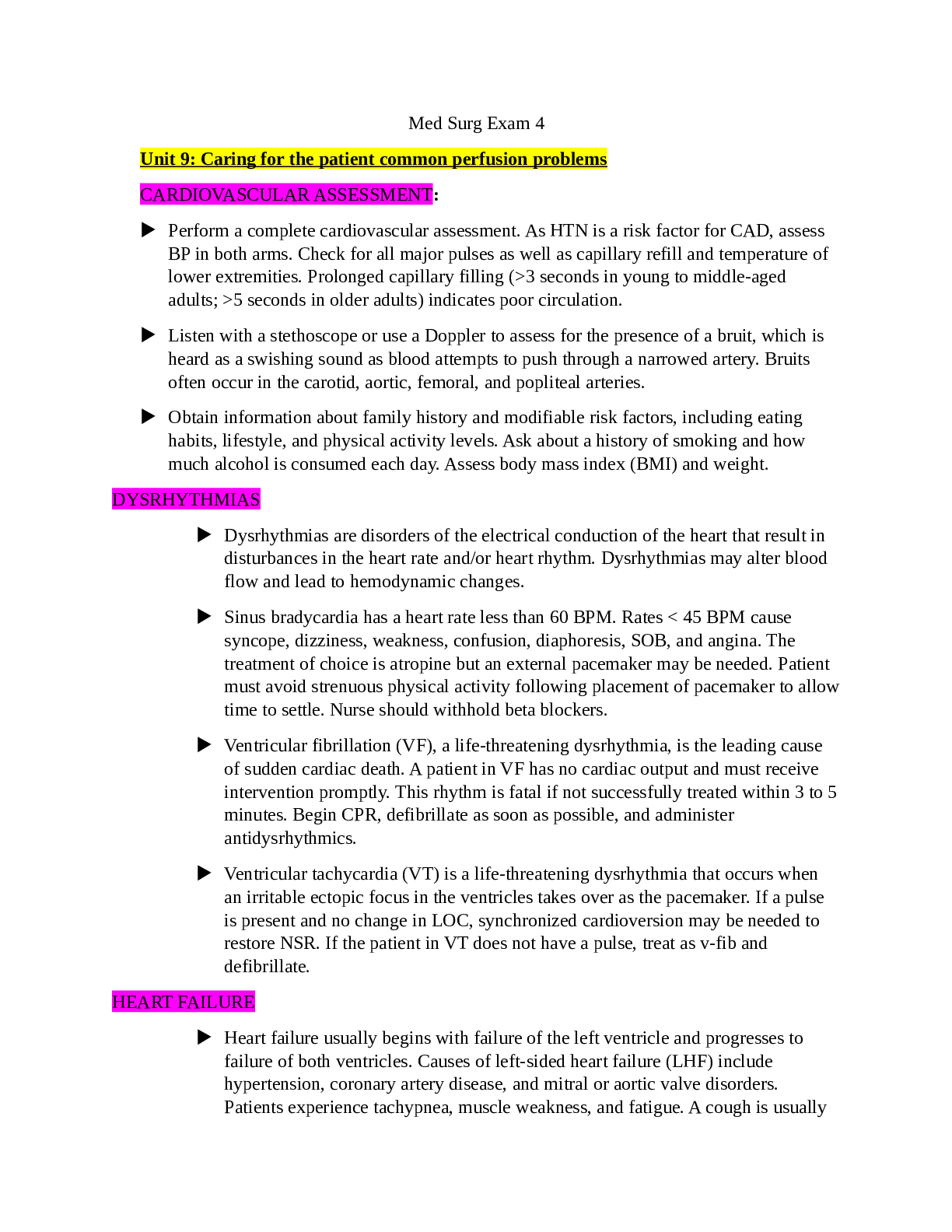Unit 9: Caring for the patient common perfusion problems
CARDIOVASCULAR ASSESSMENT: Perform a complete cardiovascular assessment. As HTN is a risk factor for CAD, assess
BP in both arms. Check for all major pulses as well as capillary refill and temperature of
lower extremities. Prolonged capillary filling (>3 seconds in young to middle-aged
adults; >5 seconds in older adults) indicates poor circulation.
Listen with a stethoscope or use a Doppler to assess for the presence of a bruit, which is
heard as a swishing sound as blood attempts to push through a narrowed artery. Bruits
often occur in the carotid, aortic, femoral, and popliteal arteries.
Obtain information about family history and modifiable risk factors, including eating
habits, lifestyle, and physical activity levels. Ask about a history of smoking and how
much alcohol is consumed each day. Assess body mass index (BMI) and weight.
DYSRHYTHMIAS
Dysrhythmias are disorders of the electrical conduction of the heart that result in
disturbances in the heart rate and/or heart rhythm. Dysrhythmias may alter blood
flow and lead to hemodynamic changes.
Sinus bradycardia has a heart rate less than 60 BPM. Rates < 45 BPM cause
syncope, dizziness, weakness, confusion, diaphoresis, SOB, and angina. The
treatment of choice is atropine but an external pacemaker may be needed. Patient
must avoid strenuous physical activity following placement of pacemaker to allow
time to settle. Nurse should withhold beta blockers.
Ventricular fibrillation (VF), a life-threatening dysrhythmia, is the leading cause
of sudden cardiac death. A patient in VF has no cardiac output and must receive
intervention promptly. This rhythm is fatal if not successfully treated within 3 to 5
minutes. Begin CPR, defibrillate as soon as possible, and administer
antidysrhythmics.
Ventricular tachycardia (VT) is a life-threatening dysrhythmia that occurs when
an irritable ectopic focus in the ventricles takes over as the pacemaker. If a pulse
is present and no change in LOC, synchronized cardioversion may be needed to
restore NSR. If the patient in VT does not have a pulse, treat as v-fib and
defibrillate.
HEART FAILURE
Heart failure usually begins with failure of the left ventricle and progresses to
failure of both ventricles. Causes of left-sided heart failure (LHF) include
hypertension, coronary artery disease, and mitral or aortic valve disorders.
Patients experience tachypnea, muscle weakness, and fatigue. A cough is usually
noted due to fluid being trapped in the lungs. Bibasilar crackles may be noted
when auscultating the lungs.
Right-sided heart failure may be caused by left ventricular failure, right
ventricular MI, or pulmonary hypertension. RHF usually results due to COPD,
pulmonary hypertension, or ARDS. Fluid is retained, resulting in edema of the
extremities. Jugular vein distention may also be present.
The diagnosis of heart failure is based on the health history data and presenting
manifestations as well as diagnostic test results. A B-type natriuretic peptide
(BNP) level will be ordered. The BNP is a protein produced and released by the
ventricles when the patient has fluid overload because of HF.
Instruct the patient to weigh daily and that 1 kg of weight gain or loss equals 1
liter of retained or lost fluid. The same scale should be used every morning before
breakfast for the most accurate assessment of weight. Instruct patients to call their
primary care provider if they gain 2 to 3 pounds in 1 day or 5 to 7 pounds in one
week.
Teach the patient energy conservation techniques, such as eating small meals and
resting afterward, as well as spacing out ADLs and activities to conserve oxygen
and avoid excessive fatigue.
CORONARY ARTERY DISEASE
The primary cause of CAD is inflammation and lipid deposition in the wall of the artery.
Arteriosclerosis is a thickening, or hardening, of the arterial wall that is often associated
with aging. Non-modifiable risk factors for CAD include age, gender, family history, and
ethnic background. The more risk factors a person has, the greater the risk of CAD.
Laboratory tests to diagnosis CAD include a lipid panel where total cholesterol, HDL,
LDL, and triglycerides are measured. Elevated cholesterol levels are confirmed by HDL
and LDL measurements. Cholesterol management focuses on an LDL < 100 mg/dL and
an HDL > 40.
Procedures to open occluded vessels are performed in the cardiac catheterization
laboratory which includes high-resolution fluoroscopy (patients may experience feeling
of heat when dye is injected) and x-ray. These procedures include angioplasty,
atherectomy, stents, and revascularization.
Coronary artery bypass graft (CABG) surgery involves the bypass of a blockage in one or
more of the coronary arteries using the saphenous veins, mammary artery, or radial artery
as conduits or replacement vessels.
ARTERIOSCLEROSIS
Read More


